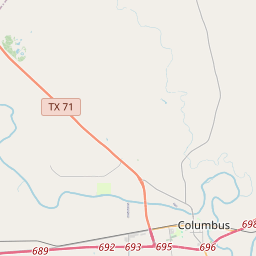The Rangers of Austin's Colony
Historical marker location:






By March 1822, Stephen F. Austin had attracted about 150 colonists to Texas. The pioneers faced many hardships, including concern for their protection form Indians along the Colorado and Brazos rivers. In December of that year, Trespalacios, the Mexican governor, divided the colony into two districts, each having an alcalde to preside over matters of local administration and captain to handle protection of the colonists.
In 1823, after several Indian attacks on members of Austin's colony, Captain Robert Kuykendall and Alcalde John Tumlinson of the Colorado District requested permission form Tresplacios to raise a company to protect the colonists. Ten men were recruited to serve under the command of Moses Morrison.
When Stephen F. Austin returned from Mexico City in August 1823, he found the colony still plagued by Indian disturbances and announced that he would employ ten additional men, at his own expense, to serve as "Rangers" for the common defense.
Although the law enforcement group known as the Texas Rangers was not formally organized until 1835, the "Rangers" of Austin's Colony are the earliest recorded force of this type raised in Texas and served as a model for the later formation of the Texas Rangers.
Texas Sesquicentennial 1836 - 1986
As one of the most visible programs of the Texas Historical Commission (THC), historical markers commemorate diverse topics in Texas history, including: the history and architecture of houses, commercial and public buildings, religious congregations, and military sites; events that changed the course of local and state history; and individuals who have made lasting contributions to the state, community organizations, and businesses.
More history nearby
Texas is known for its love of football, and the state has produced many great football players, including legends like Tom Landry, Earl Campbell, and Vince Young.
During the Republic of Texas era, Colorado County saw rapid growth and development. The county seat, Columbus, was established in 1839 and quickly became a major commercial center. The town served as an important stop on the Old San Felipe Road, a major transportation route connecting East and Central Texas. The discovery of oil and gas in the region in the early 20th century further fueled the county's growth and economic prosperity.
Colorado County played an important role during the Civil War. Many residents of German descent who settled in the county were Union sympathizers, while others supported the Confederacy. The county witnessed several skirmishes and military actions, including the Battle of Columbus in 1862, when Confederate forces repelled a Union raid. After the war, the county slowly rebuilt its economy and infrastructure.
In the 20th century, Colorado County diversified its economy beyond agriculture. The discovery of oil and gas led to the development of a thriving energy industry, and manufacturing and services sectors also grew. Today, Colorado County is a mix of suburban and rural areas, with agriculture, oil and gas, and tourism forming the pillars of its economy. The county continues to preserve its historical sites and celebrate its diverse heritage, attracting visitors from across the state and beyond.
Colorado County Timeline
This timeline provides a concise overview of the key events in the history of Colorado County, Texas.
- 1821: The area that would become Colorado County, TX is included in Austin's Colony, established by the Mexican government.
- 1835: The area plays a role in the Texas Revolution as volunteers from Colorado County participate in the Battle of Gonzales.
- 1837: Colorado County is officially established as a county in the Republic of Texas.
- 1838: Columbus is selected as the county seat.
- 1846: Colorado County is incorporated into the state of Texas as it becomes part of the United States.
- 1850s: The county experiences rapid growth as more settlers move into the area, establishing farms and ranches.
- 1861: With the outbreak of the Civil War, many residents of Colorado County actively support the Confederacy.
- 1870s: The county's economy starts to diversify with the discovery of oil, leading to the establishment of oil wells and refineries.
- 1935: The Lower Colorado River Authority is established, and dams are constructed in the area for flood control and water supply.
- 1970s: Colorado County experiences an agricultural decline as farming becomes less profitable.
- 1997: The Joe R. and Teresa Lozano Long Center for the Performing Arts is opened in Austin, providing a cultural center for the region.